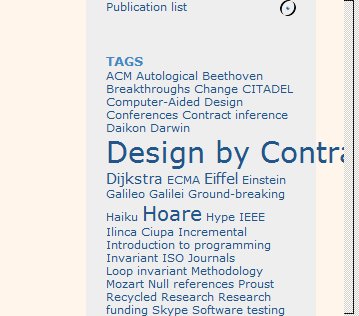Many blogs including this one rely on the WordPress software. In previous states of the present page you may have noticed a small WordPress bug, which I find interesting.
“Tags” are a nifty WordPress feature. When you post a message, you can specify one or more informative “tags”. The tags of all messages appear in the right sidebar, each with a smaller or bigger font size depending on the number of messages that specified it. You can click such a tag in the sidebar and get, on the left, a page containing all the associated messages.
Now assume that many posts use a particular tag; in our example it is “Design by Contract”, not unexpected for this blog. Assume further that the tag name is long. It is indeed in this case: 18 characters. As a side note, no problem would arise if I used normal spaces in the name, which would then appear on two or three lines; precisely to avoid this I use HTML “non-breaking spaces”. This is probably not in the WordPress spirit, but any other long tag without spaces would create the same problem. That problem is a garbled display:
The long tag overflows the bluish browser area assigned to tags, producing an ugly effect. This behavior is hard to defend: either the tag should have been rejected as too long when the poster specified it or it should fit in its zone, whether by truncation or by applying a smaller font.
I quickly found a workaround, not nice but good enough: make sure that some short tag (such as “Hoare”) appears much more often than the trouble-making tag. Since font size indicates the relative frequency of tags, the long one will be scaled down to a smaller font which fits.
Minor as it is, this WordPress glitch raises some general questions. First, is it really a bug? Assume, by a wild stretch of imagination, that a jury had to resolve this question; it could easily find an expert to answer positively, by stating that the behavior does not satisfy reasonable user expectations, and another who notes that it is not buggy behavior since it does not appear to violate any expressly stated property of the specification. (At least I did not find in the WordPress documentation any mention of either the display size of tags or a limit on tag length; if I missed it please indicate the reference.)
Is it a serious matter? Not in this particular example; uncomely Web display does not kill. But the distinction between “small matter of esthetics” and software fault can be tenuous. We may note in particular that the possibility for large data to overflow its assigned area is a fundamental source of security risks; and even pure user interface issues can become life-threatening in the case of critical applications such as air-traffic control.
Our second putative expert is right, however: no behavior is buggy unless it contradicts a specification. Where will the spec be in such an example? There are three possibilities, each with its limitations.
The first solution is to expect that in a carefully developed system every such property will have to be specified. This is conceivable, but hard, and the question arises of how to make sure nothing has been forgotten. Past some threshold of criticality and effort, the only specifications that count are formal; there is not that much literature on specifying user interfaces formally, since much of the work on formal specifications has understandably concentrated on issues thought to be more critical.
Because of the tediousness of specifying such general properties again and again for each case, it might be better — this is the second solution — to specify them globally, for an entire system, or for the user interfaces of an entire class of systems. Like any serious effort at specification, if it is worth doing, it is worth doing formally.
In either of these approaches the question remains of how we know we have specified everything of interest. This question, specification completeness, is not as hopeless as most people think; I plan to write an entry about it sometime (hint: bing for “guttag horning”). Still, it is hard to be sure you did not miss anything relevant. Remember this the next time formal methods advocates — who should know better — tell you that with their techniques there “no longer is a need to test”, or when you read about the latest OS kernel that is “guaranteed correct and secure”. However important formal methods and proofs are, they can only guarantee satisfaction of the properties that the specifier has considered and stated. To paraphrase someone [1], I would venture that
Proofs can only show the absence of envisaged bugs, never rule out the presence of unimagined ones.
This is one of the reasons why tests will always, regardless of the progress of proofs, remain an indispensable part of the software development landscape [2]. Whatever you have specified and proved, you will still want to run the system (or, for certain classes of embedded software, some simulation of it) and see the results for yourself.
What then if we do not explicitly specify the desired property (as we did in the two approaches considered so far) but testing or actual operation still reveals some behavior that is clearly unsatisfactory? On what basis do we complain to the software’s producer? A solution here, the third in our list, might be to rely on generally accepted standards of professional development. This is common in other kinds of engineering: if you commission someone to build you a house, the contract may not explicitly state that the roof should not fall on your head while you are asleep; when this happens, you will still sue and accuse the builder of malpractice. Such remedies can work for software too, but the rules are murkier because we have not accepted, or even just codified, a set of general professional practices that would cover such details as “no display of information should overflow its assigned area”.
Until then I will remember to use one short tag a lot.
References
[1] Edsger W. Dijksra, Notes on Structured Programming, in Dahl, Dijkstra, Hoare, Structured Programming, Academic Press, 1972.
[2] See Tests And Proofs (TAP) conference series, since 2007. The next conference, program-chaired by Angelo Gargantini and Gordon Fraser, will take place in the week of the TOOLS Federated Conferences in Málaga, Spain, in the week of June 28, 2010.

